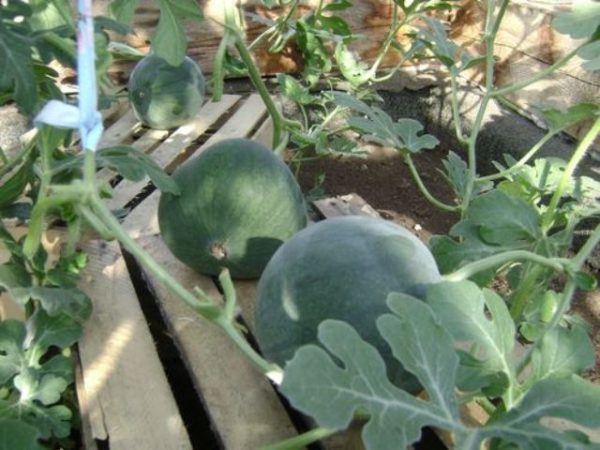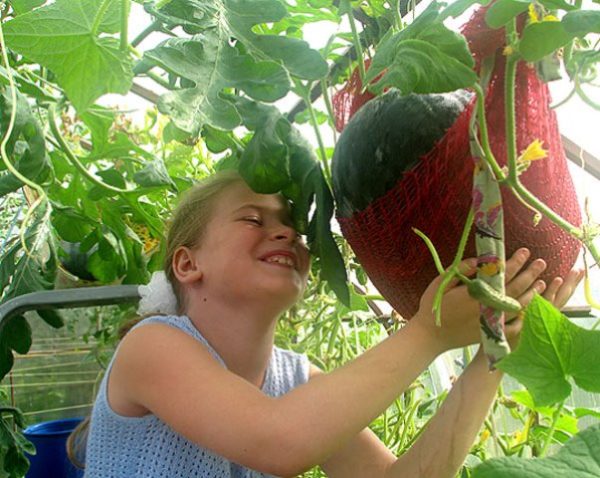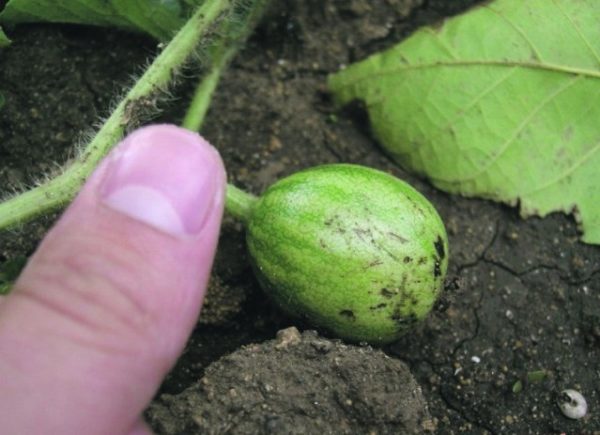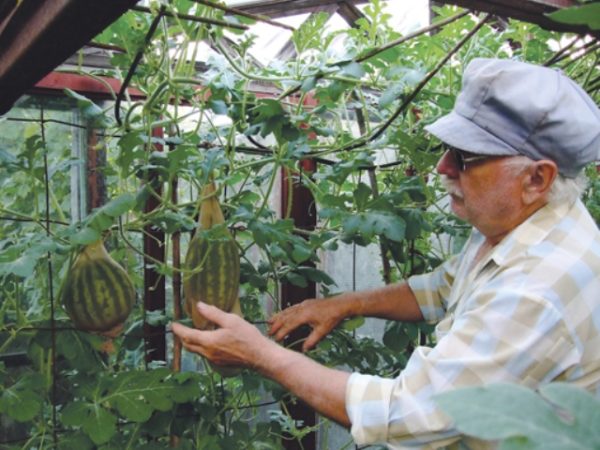Watermelon is considered a heat-loving plant, so many believe that growing such a crop in the northern or central regions is impossible. In fact, this sweet and huge berry can be obtained absolutely in any region, if you build a greenhouse on the garden plot and adhere to all the rules concerning the maintenance of plants.
Table of contents
- Is it possible to grow watermelons all year round in a greenhouse?
- The advantages of using greenhouses
- How to choose and prepare a greenhouse or greenhouse?
- Variety selection and seed purchase
- Planting and do-it-yourself culture care
- The possibility of joint planting watermelons with melons and tomatoes
- Harvesting
Is it possible to grow watermelons all year round in a greenhouse?
Growing watermelons in the greenhouse is aimed at getting the crop of this crop in the central and northern region of the country. The year-round cultivation of watermelons is unlikely to end in success, because for this crop it is necessary to comply with all the prescribed planting dates. By the way square watermelons can also be grown in a greenhouse.
A greenhouse is needed to correct the weather conditions and make them more suitable for the growth of such plants. In the off-season, the cultivation of watermelons in even in the greenhouse is unlikely to end in success, because the berry will not have enough sunlight to fully ripen. In that case, if you still get the harvest, it will not be so tasty and sugary.

The advantages of using greenhouses
Growing a watermelon in a greenhouse will help create the necessary climatic conditions and protect the plant from various natural disasters. In addition, the covering structure boasts the following advantages:
- Late return frostscharacteristic of the central and northern regions have a negative impact on the development of culture. Using the greenhouse you can not worry about this factor;
- Too much soil moisture and air can significantly affect the taste of the fruit, they will become less sweet and watery;
- Greenhouse will help to avoid various kinds of mechanical damage.
The construction of such a structure in the southern areas is not profitable, because there and without it favorable weather conditions and the crop ripens without creating additional conditions. As for other regions, the greenhouse will be an excellent way to grow such a melon crop.
How to choose and prepare a greenhouse or greenhouse?
In order to start growing watermelons in a greenhouse, you first need to build such a covering structure. The size of the land and the greenhouse itself will depend on the wishes of the gardener. It should be borne in mind that such plants are planted at a distance of 1 meter from each other, so to grow 10 bushes you need a construction with an area of 10 square meters, with a length of 5 meters and a width of 2 meters.
In order to decide on which structure will be better suited to others, their characteristics should be considered:

- The greenhouse covered with a film will be the cheapest and easiest option. The disadvantage of the design is that it cannot install additional heating, and accordingly it will not be possible to control the temperature mode in the room. Planted in such a design seedlings can be in May at home or in the country.
- Glass construction will be the most bulky, for it will have to establish a foundation. But if you build such a greenhouse, you can be confident in its durability and reliability. It is possible to build a heating system;
- Polycarbonate greenhouse will be the best option., the only disadvantage of which is the price. The design is easy to install, firmly held in place and creates opportunities for the organization of heating. Planting seedlings is possible in April. Growing fruits with their own hands is not difficult.
Before planting watermelons, a greenhouse is prepared for this process:
- Underground they lay pipes through which hot water will flow and thereby create additional heating. As the main element, you can use a gas or electric boiler;
- In order to be able to increase daylight, fluorescent lamps are installed on the roof of the structure;
- Gourds do not tolerate the occurrence of fungal diseases, so the frame, covering material and the soil must be disinfected with Brod's fluid or copper sulfate solution.
Variety selection and seed purchase
In order for a watermelon to ripen and give a good harvest, even in the northern region, it is necessary to choose the right variety, it must be zoned and refers to the early or average ripening period. The following varieties of watermelon are popular:
- Siberian;
- Moscow Charleston;
- A gift to the north;
- Light;
- Cinderella, etc.
- Near Charleston
- The light
- Gift to the north
- Siberian
Seeds suitable for growing a crop should be large and heavy.Hollow planting material will not be able to adapt to environmental conditions.
Planting and do-it-yourself culture care
In order to grow a watermelon in a greenhouse, you need to take into account many factors affecting this process. In addition to their need to care for, water and feed.
Growing seedlings
In order to get watermelons from seeds, it is first necessary to grow seedlings.. It is necessary to plant seeds at the end of April. As a fertile soil using a mixture of pernoy, sod land, sand and mineral fertilizers.
Peat pots, plastic cups or cut bottles filled with fertile soil are used as containers for growing seedlings.Seeds are sown one by one, deepening them by 3-4 centimeters.

In order for seedlings to appear as quickly as possible, the capacity must be kept in a room with a temperature not lower than 25 degrees. With further cultivation of seedlings should follow some rules:
- Light day should be at least 14 hours a day;
- Watering seedlings must be very careful not to fall on the foliage of the plant;
- Pots should be placed at a distance of 20-30 centimeters from each other;
- Watermelons respond well to making mineral dressings.
Planting seedlings in the greenhouse
Before planting watermelon seedlings in greenhouses, it is necessary to prepare the soil. This culture prefers fertile soils with neutral acidity. To achieve the best result under the digging, the following components are introduced:
- humus;
- peat;
- superphosphate;
- potassium salt;
- ammonium sulfate.
The next step will be the formation of bulk ridges, which are located along the walls of the greenhouse. Their height should be equal to 30 centimeters, and width 50-80 centimeters. The optimal distance between rows is 1 meter.
Planting seedlings carried out according to the following algorithm:
- To start digging the wells with a depth of 10 centimeters;
- Saplings are taken from the tank together with the earthy clod. This is to avoid damage to the root system;
- Plants are staggered at a distance of 50-70 centimeters from each other;
- The penetration of the root collar into the soil can cause rotting, so it is left on the surface;
- After the seedling is in the ground it is necessary to water it and mulch the sawdust.

Proper temperature and lighting
In the best way, a watermelon develops and forms its fruits at an air temperature of 30 degrees. To avoid condensation, the greenhouse is periodically ventilated, while avoiding drafts.
The optimal light day should be 14 hours.. With a lack of this indicator, you must use artificial lighting. Watermelon reacts poorly to open sunshine, so on too hot and hot days the walls slightly shade the greenhouse.
How often to water the berries?
Watermelons have a deep root system., thanks to which the plant can extract moisture from the deep layers of the soil.How often is watering done? Watering the bushes is necessary only when the leaves begin to fade slightly. In this case, the risk of overmoistening is minimized. During watering should avoid falling drops on the leaves and shoots of the plant.
To obtain the richest harvest, once a month, the soil is watered with complex mineral fertilizers diluted in water. Also, before the formation of the fruit, every 2 weeks the bushes were fed ammonium nitrate.
Plant formation
Getting a rich harvest depends on how the bushes were formed:

- The point of growth must be pinned over the fifth sheet;
- On the two lower shoots flowers appear later than the others, so the fruits do not have time to ripen. Such whips are removed immediately after they appear;
- Shoots without ovaries are also removed;
- In order for the berries to develop well, the shoots are tied to a trellis. Perform such work under the second or third sheet. As the growth of lashes, they are periodically twisted;
- Side shoots, which formed the ovary, are also subject to pruning.They are stopped above the third leaf above the female flowers and above the seventh sheet above the male flowers.
Experienced gardeners believe that watermelons should not lie on the ground during the ripening of fruits, so they are placed in a separate net and suspended from the trellis.
Pollination
After the yellow flowers appear, they will need to be self-pollinated. In the open ground, bees cope with this work, but there are no such “workers” in the greenhouse. The whole process takes place according to the following rules:
- It is very important not to miss the indicated deadlines, because the male flowers fall off after a few hours, and the female flowers will be able to pollinate for only 3 days;
- Male flowers (the largest and without the ovary) gently tear and remove the petals so as not to damage the pollen;
- Stamens are applied to the pistils several times.
The possibility of joint planting watermelons with melons and tomatoes
Growing watermelons in the greenhouse is quite an interesting process and with proper skill this culture can be located in the same room with other plants:
- In order not to wait for favorable time for planting watermelons, early greens or radishes can be grown in the greenhouse, which will be useful predecessors;
- Watermelon is a drought-resistant crop, next to which tomatoes and eggplants are successfully grown. These plants have similar needs and rules in the care.
- Melons are also good neighbors for watermelons. By the way, they can be planted even on the same bed.

Harvesting
Harvesting usually begins in mid-late August. The full maturity of the fruit can be judged by the following features:
- the junction of the berries and the whip is partially dry;
- a bright pattern appears on the surface of the watermelon;
- when tapping, you can hear a deaf sound and feel the vibration.
Growing watermelons in a greenhouse is a very painstaking process that requires constant monitoring of various indicators. With this design, it is possible to grow melon crops not only in the south, but also in the north and in other regions.




